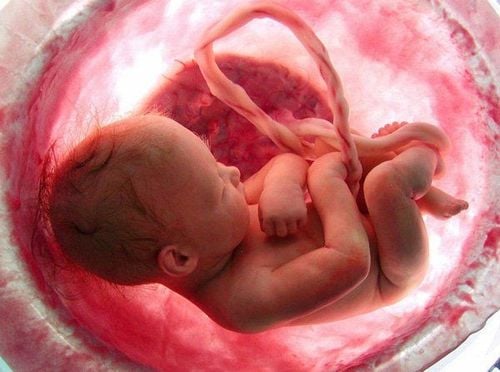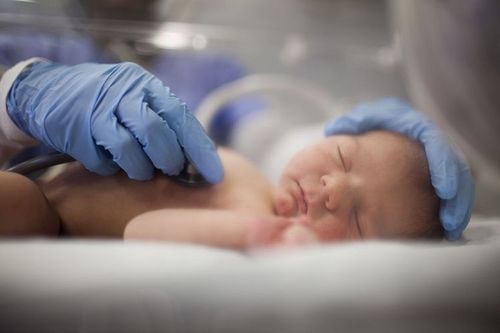This is an automatically translated article.
Hypoplastic left heart syndrome is a complex and rare heart defect at birth (congenital). In this condition, the left side of the heart is severely underdeveloped. If your baby is born with hypoplastic left heart syndrome, the left part of the heart cannot pump blood to the body effectively.1. What is left ventricular hypoplasia syndrome? (HLHS)
Hypoplastic left ventricular syndrome, also known as hypoplastic left heart syndrome (HLHS) is a severe congenital heart defect in which the left side of the heart is underdeveloped.In a normal heart, the left side of the heart is responsible for pumping oxygenated blood into the aorta, the large artery that carries blood to the body. In a child with HLHS:
The mitral valve, which separates the two left chambers of the heart, is too small or closes completely (atria). The left ventricle (lower, pumping chamber) is very small. The aortic valve, which separates the left ventricle and aorta, is too small or closes completely (atretic).
2. Causes of left ventricular hypoplasia in the fetus
Hypoplastic left heart syndrome occurs when a baby's heart is developing in the womb. However, if a child in your family has hypoplastic left heart syndrome, the risk of having another child with the same condition increases.As the heart does its basic job pumping blood around the body the heart uses the left and right sides for different tasks. The right side moves blood to the lungs. In the lungs, oxygen enriches the blood, which then circulates to the left side of the heart. The left side of the heart pumps blood into a large vessel called the aorta, which helps circulate oxygen-rich blood to the rest of the body.
3. What happens in hypoplastic left heart syndrome?
In hypoplastic left heart syndrome, the left part of the heart cannot supply blood to the body correctly because the lower left chamber (left ventricle) is too small or in some cases nonexistent.During the first days of life, the right side of the heart can pump blood to the lungs and the rest of the body through a blood vessel that connects the pulmonary artery directly to the aorta (also known as the ductus arteriosus). Oxygen-rich blood returns to the right side of the heart through a natural opening (foramen ovale) between the right heart chambers (atria).
If the ductus arteriosus and ovaries close, which they usually do after the first day or two of life, the right side of the heart has no way to pump blood out of the body. In children with hypoplastic left heart syndrome, medication is needed to keep these connections open and keep blood flowing to the body until heart surgery is performed.

Thiểu sản thất trái là một dị tật tim phức tạp và hiếm gặp
4. Signs and symptoms of HLHS
The following symptoms of hypoplastic left heart syndrome may appear at birth or a few days later:Blue or purple color of lips, skin and fingernails (cyanosis) Difficulty breathing Difficulty feeding Coma (drowsiness) or unresponsive) HLHS examination and diagnosis Signs of shock include:
Soft, cool skin, which may be pale or gray Weak and rapid pulse Abnormal breathing that may be slow and shallow or very rapid Usually, Hypoplastic left heart syndrome is diagnosed before birth by fetal echocardiography (ultrasound). Monitoring fetal echocardiography can help you prepare for your birth plan and provide immediate care after birth.
Sometimes HLHS is diagnosed hours or days after birth and the baby will need treatment right away. Diagnosis of HLHS may require some or all of the following tests:
Echocardiogram (also called "echo" or ultrasound): Sound waves create an image of the heart Electrocardiogram (ECG): Electrical activity recording of the heart Chest X-ray Oxygen measurement: A non-invasive way to monitor blood oxygen levels Cardiac catheterization: A thin tube is inserted into the heart through a vein or artery in the leg or through the navel ("" umbilicus") Cardiac MRI: A three-dimensional image that shows abnormalities of the heart.
5. Treatment of hypoplastic left heart syndrome
Hypoplastic left heart syndrome is the most common cause of death without early intervention. There are now many different options for treating this complex heart condition, an individual approach taken for each and every child. Your doctor will explain each option individually and why a particular approach might be recommended for your child.5.1. Surgery for hypoplastic left heart syndrome Usually, your doctor will recommend open heart surgery to redirect oxygen-rich and oxygen-poor blood. After these operations:
The right side of the heart will do what is normally the job of the left side pumping oxygenated blood to the body. Deoxygenated blood flows from the veins to the lungs without going through the heart. Regular surveillance in infancy and childhood is important to minimize risk factors for surgery. Your child will also need a series of customized diagnostic tests between planned surgeries and throughout childhood. Additional surgical or catheterization therapies, or in rare cases, may also be recommended.
5.2. Follow-up care Although initial outcomes for patients with monoventricular malformations after staged reconstruction have been significantly improved, the interval between surgery remains a highly vulnerable time. for infants.
By age 18 children who have had HLHS reconstructive surgery require lifelong care by a cardiologist with experience in congenital heart disease. Sometimes they have serious health problems. Many people still need medication and may require additional surgery.
According to one group, children with complex congenital heart defects who received open-heart surgery at an early age also have a higher risk of neurodevelopmental problems than children without congenital heart defects.

Hội chứng thiểu sản tim trái giảm sản thường gây tử vong nhất nếu không điều trị sớm
Gathering a team of leading pediatricians: including leading experts, with high professional qualifications (professors, associate professors, doctorates, masters), experienced, worked at major hospitals such as Bach Mai, 108.. Doctors All of them are well-trained, professional, have a mind - range, and are knowledgeable about young psychology. In addition to domestic pediatric specialists, the Department of Pediatrics also has the participation of foreign experts (Japan, Singapore, Australia, USA) who are always pioneers in applying the latest and most effective treatment regimens. . Comprehensive services: In the field of Pediatrics, Vinmec provides a series of continuous medical examination and treatment services from Newborn to Pediatric and Vaccine, ... according to international standards to help parents take care of their baby's health from birth to childhood. from birth to adulthood Specialized techniques: Vinmec has successfully deployed many specialized techniques to make the treatment of difficult diseases in pediatrics more effective: neurosurgery - skull surgery, stem cell transplantation. blood in cancer treatment. Professional care: In addition to understanding children's psychology, Vinmec also pays special attention to the children's play space, helping them to have fun and get used to the hospital's environment, cooperate in treatment, improve the efficiency of medical treatment.
Please dial HOTLINE for more information or register for an appointment HERE. Download MyVinmec app to make appointments faster and to manage your bookings easily.













